Beginning with Chapter One in A Princess
of Mars (Under the Moons of Mars), longevity was an on-going theme
explored by Edgar Rice Burroughs. This article identifies eight different
variations on the theme of longevity, eternal life, and immortality presented
by Edgar Rice Burroughs in his novels and stories. Let’s begin with his
first published paragraph.
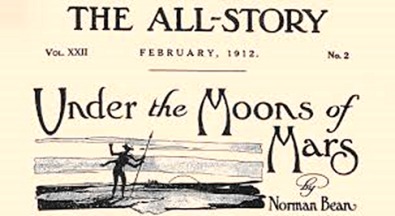
“I am a very old man; how old I do not know.
Possibly I am a hundred, possibly more; but I cannot tell because I have
never aged as other men, nor do I remember any childhood. So far as I can
recollect I have always been a man, a man of about thirty. I appear today
as I did forty years and more ago, and yet I feel that I cannot go on living
forever; that some day I shall die the real death from which there is no
resurrection. I do not know why I should fear death, I who have died twice
and am still alive; but yet I have the same horror of it as you who have
never died, and it is because of this terror of death, I believe, that
I am so convinced of my mortality.”
Burroughs wrote about the extension of life or the perceived
extension of life several times and in several ways. This article is intended
to list and make observations about those. While it is intended to be as
complete as possible, I’ll probably miss something and look forward to
guidance from others.
The paragraph referenced above from A Princess of
Mars makes a direct statement. Some men live longer than others.
Burroughs’ alter ego, John Carter, is such a man. To live more than a hundred
years and still be a vibrant warrior would be “The stuff dreams are made
of,” to quote Dashiell Hammett.
No explanation of Carter’s perception of his age is ever
given. We’re told that he doesn’t know his age, but that he has never aged
as other men. If one looks at the timeframe when the story was written,
fifty
years after the civil war, we could project Carter’s true age at the time
he encountered Burroughs to be in the seventies.
However, Fredrik Ekman, noted Burroughs scholar,
summarist, and ERBAPA member sees it differently. Ekman correctly points
out that in the very beginning of the first chapter of Princess, Burroughs
(Carter) writes: "I am a very old man; how old I do not know. Possibly
I am a hundred, possibly more; but I cannot tell because I have never aged
as other men, nor do I remember any childhood." This was written in
1866, plus ten to twenty years, so we can draw the conclusion that Carter
has memories as far back as the late 18th Century. Ekman interprets the
passage to indicates Carter was already immortal before he went to Barsoom.
I agree.
He spent several years on Barsoom. Perhaps, something
in the Barsoomian atmosphere or the instantaneous transportation between
planets retards the aging process or even reboots it.
Carter’s agelessness could be a result of his birth,
born that way, if you will, it could be from the Barsoomian environment,
or it could be from the transition process. It might be a combination.
Whichever, John Carter is not as other men. He is a “Special Person.”
The following is not meant to be a complete summary of
A
Princess of Mars, but only to guide us through how the story predicts
Joseph Campbell’s not yet established requirements for a hero.
The paragraph quoted above immediately sets Carter aside
from other men. A quick review shows how John Carter quickly fulfills the
steps outlined by Joseph Campbell in The Hero’s Journey.
In fact, A Princess of Mars could be the outline for Campbell’s
works on heroes. First, the hero is different from other men. Think Achilles’
invulnerability, Moses and the bulrushes, or even the virgin birth. Heroes
are different. An ageless John Carter is SPECIAL. Without going into painstaking
detail, Step one of the hero’s journey is Separation. It frequently involves
spiritual aid. Sometimes, Campbell calls this step, “Meeting the White
Spirit.” Carter is separated from the life he knows. He runs from the natives
and hides in a cave. Finding the mummy of the old woman in the cave clearly
begins this step. Next, Carter goes to sleep and wakes up on another planet.
A hero must cross the First Threshold, the descent into
the abyss. Well, Good Morning, Barsoom. Next, comes Endurance of the Ordeal.
Carter’s capture by the Tharks, battle for acceptance, and finding an unacknowledged
love, Dejah Thoris, are classic examples of “The Hero at the First Threshold.”
This brings the reader to Campbell’s Act Two, The Supreme
Ordeal. Carter learns the language and becomes a quasi-accepted member
of the Tharks. He is stabbed in the chest by Zad during a duel, but is
treated with a salve and miraculously survives. This second resurrection
could have reset Carter’s age clock, but we don’t know. (Consider Carter’s
rebirth on Barsoom as his first resurrection. Carter and Dejah Thoris escape
the Tharks, but Carter is captured by the Warhoons where he is forced to
fight a newly found friend in a gladiatorial contest. He and his mock adversary
escape.
In Campbell’s Act Three, Unification, Carter reunites
with the Tharks and battles the evil Zodangans. Carter and Dejah Thoris
marry, but before they can live happily ever after, the atmosphere plant
fails and all life on Barsoom is threatened. This satisfies the next Campbell
required Hero point, Ultimate Sacrifice. Carter restarts the atmosphere
plant, but falls unconscious. He saves the planet, but loses his love,
Dejah Thoris, and perhaps his life.
He is resurrected one more time in the Arizona cave. Ten
years have passed, but he hasn’t aged. Carter is presented as the ageless
hero, who when faced with death is resurrected somewhere else.
In A Princess of Mars, Burroughs gives us
another example of “Extended Life”. Barsoomians, Red or Yellow, Green or
White, live for a thousand years. This is presented as a statement of fact
and this article will not comment on that. They live that long. Maybe it’s
the dry air.
So, we have two methods for longevity. Be born an ageless
hero who is resurrected on two planets or be born on Barsoom and live a
thousand years.
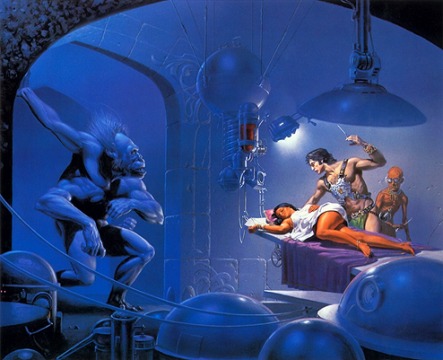
Burroughs offers another method to achieve long life in the
novel, The Mastermind of Mars. In Chapter One, the hero,
Ulysses Paxton, saves an old man’s life and then watches the old man, Ras
Thavas, perform an operation where the brains and blood of an old woman
and a young woman are exchanged. The purpose of the surgery is to extend
the life of the old woman by putting her brain in a young body. This is
the third ERB presented method to extend human life discussed in this article.
What better way to live long and prosper than to simply buy a new body.
If a thousand years isn’t enough, just find a young person and take their
body.
In reality, a brain transplant or whole-body transplant
is a procedure in which the brain of one organism is transplanted into
the body of another organism. It is a procedure distinct from head transplantation,
which involves transferring the entire head to a new body, as opposed to
the brain only. Theoretically, a person with advanced organ failure could
be given a new and functional body while keeping their own personality,
memories, and consciousness through such a procedure.
No human brain transplant has ever been conducted. Neurosurgeon
Robert J. White grafted the head of a monkey onto the headless body
of another monkey. EEG readings showed the brain was later functioning
normally. It was thought to prove that the brain was an immunologically
privileged organ, as the host's immune system did not attack it at first,
but immunorejection caused the monkey to die after nine days. In the 1990s,
White transplanted several monkey heads onto other bodies, but the bodies
remained paralyzed.
The third method to achieve longevity explored by ERB
is surgical transplantation.
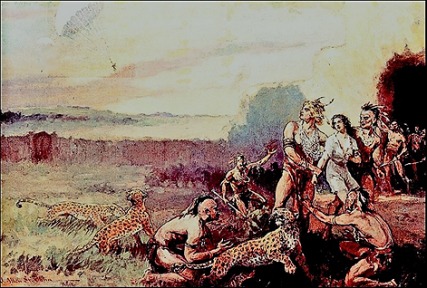
Leaving Barsoom, we’ll return to Earth and the novel,
Tarzan’s
Quest.
In chapter twenty-nine, Kavandavanda, who is worshipped
by the Kavuru claims to be thousands of years old and that there is no
such thing as god. The Karvuru are a cult of celibate priests who have
achieved immortality with an elixir made from Kavuru pollen, spinal fluid
of leopards, and the glands and blood of young women. Sounds messy, but
the priests make immortality pills from the combination.
They may not actually live thousands of years, but celibacy
may make it seem that way.
Tarzan, Jane, and their companions appropriate the pills
of eternal youth (the ones made by the Kavuru), but the pills have to be
taken once a month and surely, the supply wasn’t endless and the Kavuru
pills were divided equally between Tarzan, Jane, Brown, Annette, Tibbs,
and Nkima. The novel doesn’t discuss how long the supply will last. There’s
also the whole celibacy requirement. Maybe, that’s why Tarzan’s Quest
is Jane’s last appearance in novels.
Philip Jose Farmer concluded that the pills’ effect was
permanent and would make the pill-taker immortal (subject to death by murder,
war, or misadventure) when he postulated an eternal Tarzan in Time’s
Last Gift and Tarzan and the Dark Heart of Time.
The fourth method to achieve longevity is witchcraft
or magic.
Interestingly enough, NASA started research trials using
anti-aging pills in 2017. Nicotinamide adenine dinucleotide, or NAD, is
a coenzyme (a compound that certain enzymes need to work) in every cell
that is crucial to the basic reactions in your cells that keep you alive.
Your cells use NAD+ to make sirtuin proteins work. Proteins
that regulate biological pathways called sirtuin protect your cells from
age-related decline. Sirtuins play a crucial role in maintaining the length
of telomeres, DNA strand end caps that keep our chromosomes from unraveling.
Scientists have linked long telomeres with longevity.
In a Bulletproof Radio podcast episode, UCSF professor
and co-author of New York Times bestseller, “The Telomere Effect,”
Elissa Epel, Ph.D., explains, “When we measure telomeres in midlife, they’re
a pretty reliable predictor of who gets disease early and, in some studies,
who dies early. They do matter when we’re older.”
Because you want long telomeres and the longevity that
goes along with them, you need plenty of NAD+ to keep them working efficiently.
Who knew, and they don’t use the blood and glands of young women or leopard
spinal fluid to make the NAD+ pills.
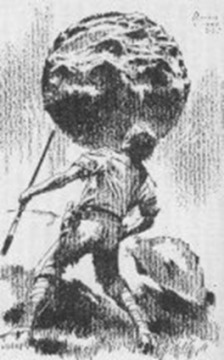 Burroughs explores an interesting variation on this theme
in At The Earth’s Core. How long would people live if they
had no concept of time? In a world without sunrise or sunset, without a
moon or stars, people wouldn’t observe or understand time. Perhaps, time
is an artificial construct invented by surface people. Don’t confuse this
with the John Carter concept of “I don’t know how old I am.” This is an
entire world, a timeless world, where people separated can age at different
rates – or seemingly not at all. Essentially and simply put, if there is
no perception of the passage of time, there is no age. People in Pellucidar
do grow up, grow older, and eventually die.
Burroughs explores an interesting variation on this theme
in At The Earth’s Core. How long would people live if they
had no concept of time? In a world without sunrise or sunset, without a
moon or stars, people wouldn’t observe or understand time. Perhaps, time
is an artificial construct invented by surface people. Don’t confuse this
with the John Carter concept of “I don’t know how old I am.” This is an
entire world, a timeless world, where people separated can age at different
rates – or seemingly not at all. Essentially and simply put, if there is
no perception of the passage of time, there is no age. People in Pellucidar
do grow up, grow older, and eventually die.
This could fall into the “What you don’t know can’t hurt
you” category. If you don’t know about time, you never consider how old
you are. If your brain has no concept of aging, it doesn’t tell the body
to age. Circular reasoning from where I sit, but some scientists have differing
thoughts on the matter.
The fifth Burroughs to achieve longevity is to ignore
time. There is no aging where there is no passage of time.
Burroughs wasn’t that far off the mark. www.space.com
published an article on time July 6, 2016, and the following is an excerpt
from that article.
To appreciate time is to feel the fabric of
reality. I interview physicists and philosophers on my public television
series, Closer to Truth, and many assert that time is an illusion.
What do they mean that time is "not real?"
Huw Price, professor of philosophy at Cambridge University,
claims that the three basic properties of time come not from the physical
world but from our mental states: A present moment that is special; some
kind of flow or passage; and an absolute direction. "What physics gives
us," Price said, "is the so-called 'block universe,' where time is just
part of a four-dimensional space-time … and space-time itself is not fundamental
but emerges out of some deeper structure." We sense an "arrow" or direction
of time, and even of causation, he said, because our minds add a "subjective
ingredient" to reality, "so that we are projecting onto the world the temporal
perspective that we have as agents [in this environment]."
Think of the block universe, which is supported by
Einstein's theory of relativity, as a four-dimensional space-time structure
where time is like space, in that every event has its own coordinates,
or address, in space-time. Time is tenseless, all points equally "real,"
so that future and past are no less real than the present. alse import
to the present moment? "We can portray our reality as either a three-dimensional
place where stuff happens over time," said Massachusetts Institute of Technology
physicist Max Tegmark, "or as a four-dimensional place where nothing happens
[‘block universe’] — and if it really is the second picture, then change
really is an illusion, because there's nothing that's changing; it's all
just there — past, present, future.
"So life is like a movie, and space-time is like the
DVD," he added; "there's nothing about the DVD itself that is changing
in any way, even though there's all this drama unfolding in the movie.
We have the illusion, at any given moment, that the past already happened
and the future doesn't yet exist, and that things are changing. But all
I'm ever aware of is my brain state right now. The only reason I feel like
I have a past is that my brain contains memories.
Did ERB’s theory about timelessness as presented in the Pellucidar
novels foreshadow some current scientific thinking? It would appear so.
Good for him. Sometimes, I wish I’d never seen a clock.
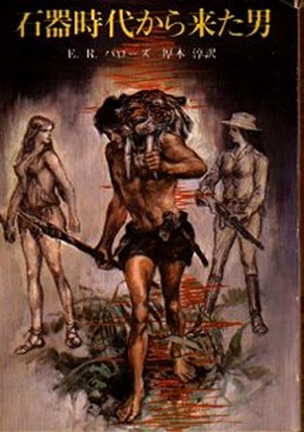 In The Eternal Lover, Edgar Rice Burroughs
explores other methods to achieve extended or eternal life – reincarnation,
universal memory, and suspended animation. He presents Nu, Son of Nu and
Victoria Custer, the reincarnation of his love, Nat-al. Nu, a prehistoric
troglodyte, was trapped in a cave by an earthquake. In modern times, another
earthquake opens the cave and Nu wakes up in 20th Century Africa. He has
been in suspended animation. He and Victoria (Nat-al) meet and realize
they are soul mates. After many adventures, the two take shelter in the
cave. A third earthquake knocks Nu senseless and buries him in the cave.
Nat-al wakes with her prehistoric family, but with dreams of her future
life as Victoria. She and Nu are united, separated, and reunited. They
return to the village. Nu leaves to hunt and a fourth earthquake drops
the curtain over the prehistoric scene.
In The Eternal Lover, Edgar Rice Burroughs
explores other methods to achieve extended or eternal life – reincarnation,
universal memory, and suspended animation. He presents Nu, Son of Nu and
Victoria Custer, the reincarnation of his love, Nat-al. Nu, a prehistoric
troglodyte, was trapped in a cave by an earthquake. In modern times, another
earthquake opens the cave and Nu wakes up in 20th Century Africa. He has
been in suspended animation. He and Victoria (Nat-al) meet and realize
they are soul mates. After many adventures, the two take shelter in the
cave. A third earthquake knocks Nu senseless and buries him in the cave.
Nat-al wakes with her prehistoric family, but with dreams of her future
life as Victoria. She and Nu are united, separated, and reunited. They
return to the village. Nu leaves to hunt and a fourth earthquake drops
the curtain over the prehistoric scene.
When I read this story for the first time over fifty years
ago, I was convinced that Nu and Victoria were engaged in some sort of
mental time travel. I don’t believe that’s the case. My observation that
Nu survived in suspended animation is questionable when the evidence of
his skull is considered, along with his return to the era of his birth.
Most people who believe in reincarnation, are clear that the reincarnated
don’t remember previous lives. I have no experience in the phenomena, but
Victoria clearly saw glimpses of her life as Nat-al and Nat-al dreamt of
her future life as Victoria.
It appears that Nu slept through the years in suspended
animation, returned to the past during an earthquake, and died there. His
skull made the trip one more time. There is no explanation of his return
to the past. This story touches on suspended animation, but has elements,
such as the return to the past, that don’t make it fit that category. That
leaves us with Victoria Custer, the reincarnation of Nat-al, and hints
at Universal Memory.
Reincarnation, ERB’s sixth way to achieve longevity.
I’m not going to commit to interpreting Nu’s journey or
part of that journey as suspended animation, but we’ll visit that concept
in the next section.
The word "reincarnation" derives from Latin, and literally
means, "entering the flesh again". An alternate term is transmigration
implying migration from one life (body) to another. Reincarnation refers
to the belief that an aspect of every human being (or all living beings
in some cultures) continues to exist after death, this aspect may be the
soul or mind or consciousness or something transcendent which is reborn
in an interconnected cycle of existence; the transmigration belief varies
by culture, and is envisioned to be in the form of a newly born human being,
or animal, or plant, or spirit, or as a being in some other non-human realm
of existence.
At the time Burroughs wrote The Eternal Lover,
popular awareness of the idea of reincarnation was boosted by the Theosophical
Society's dissemination of systematized and universalized Indian concepts
and also by the influence of magic societies like The Golden Dawn. Notable
personalities like Annie Besant, W. B. Yeats and Dion Fortune made the
subject almost as familiar an element of the popular culture of the west
as of the east.
Theodore Flournoy was among the first to study a claim
of past-life recall in the course of his investigation of the medium Hélène
Smith, published in 1900, in which he defined the possibility of cryptomnesia
(secret or hidden memories) in such accounts. Flournoy left doubt about
whether that Hélène Smith drew from subconscious memories
of her present life rather than memories of previous incarnations, but
Smith, herself, either believed or falsely claimed that she that she remembered
past lives and different incarnations. Carl Jung emulated Flournoy in his
thesis based on a study of cryptomnesia in psychism. Later Jung would emphasize
the importance of the persistence of memory and ego in psychological study
of reincarnation: "This concept of rebirth necessarily implies the continuity
of personality... one is able, at least potentially, to remember that one
has lived through previous existences, and that these existences were one's
own...." Hypnosis, used in psychoanalysis for retrieving forgotten memories,
was eventually tried as a means of studying the phenomenon of past life
recall.
“The Resurrection of Jimber-Jaw” is
a short story about suspended animation, but not resurrection in the truest
sense of the word. What better way to live forever than to sleep without
aging for extended periods of time. It worked for Rip Van Winkle. In the
story, a cave man, who the narrator, Morgan, calls Jimber-Jaw is discovered
frozen in a glacier. He is thawed in a laboratory, given new blood and
unnamed solutions and chemicals. He wakes up. After a time he discovers
he doesn’t care for the modern world and asks to be refrozen, but that’s
beyond the scope of this article.
Suspended Animation, the seventh longevity method used
by Edgar Rice Burroughs in a story.
Suspended animation is the inducement of a temporary cessation
or decay of main body functions, including the brain, to a hypometabolic
state in order to try to preserve its mental and physiological capabilities.
As a theoretical concept, it has been included in a wide
range of fiction books and films but has not been implemented as a medical
procedure for either short or extended time.
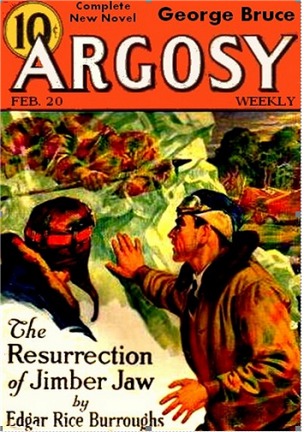 Suspended animation has been defined as the slowing or stopping
of life processes without terminating life itself. Breathing, heartbeat
and other involuntary functions may still occur, but they can only be detected
by artificial means. For this reason, this procedure has been associated
with a lethargic state in nature when animals or plants appear, over a
period, to be dead but then can wake up without suffering any harm.
Suspended animation has been defined as the slowing or stopping
of life processes without terminating life itself. Breathing, heartbeat
and other involuntary functions may still occur, but they can only be detected
by artificial means. For this reason, this procedure has been associated
with a lethargic state in nature when animals or plants appear, over a
period, to be dead but then can wake up without suffering any harm.
This has been termed in different texts as hibernation
or dormancy.
This condition of apparent death or interruption of vital
signs may be similar to the medical interpretation of suspended animation.
It is only possible to recover signs of life if the brain and other vital
organs suffer no cell deterioration, necrosis or molecular death principally
caused by oxygen deprivation or excess temperature (especially high temperature).
There are examples of people that have returned from this
apparent interruption of life lasting over half an hour, two hours, eight
hours or more while adhering to these specific conditions for oxygen and
temperature that have been reported and analyzed in depth, but these cases
are not considered scientifically valid. The brain begins to die after
five minutes without oxygen; nervous tissues die intermediately when a
"somatic death" occurs while muscles die over one to two hours following
this last condition.
It has been possible to obtain a successful resuscitation
and recover life in some instances, including after anesthesia, heat stroke,
electrocution, narcotic poisoning, heart attack or cardiac arrest, shock,
newborn infants, cerebral concussion, cholera, and voluntarily as in yogis.were
able to preserve the minimum conditions in an environment extremely close
to death and return to a normal living state. An example of such a case
was Anna Bågenholm, a Swedish radiologist who allegedly survived
40 minutes under ice in a frozen lake in a state of cardiac arrest and
survived with no brain damage in 1999.
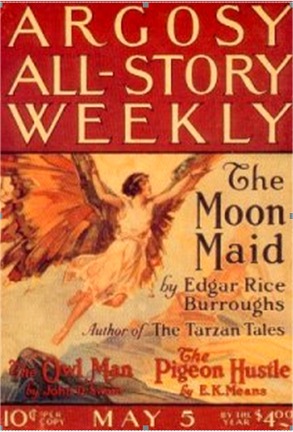 In The Moon Maid, Edgar Rice Burroughs presents
a form of longevity that is particularly unique – Inherited and Foretold
Memory. For the purposes of this article, I’ll call it “Universal Memory.
Burroughs called it reincarnation, but it is more than that. The narrator
meets Julian 3rd, who promptly says,
In The Moon Maid, Edgar Rice Burroughs presents
a form of longevity that is particularly unique – Inherited and Foretold
Memory. For the purposes of this article, I’ll call it “Universal Memory.
Burroughs called it reincarnation, but it is more than that. The narrator
meets Julian 3rd, who promptly says,
“Do you realize that there is no such thing
as Time?” he asked suddenly—“That man has invented Time to suit the limitations
of his finite mind, just as he has named another thing, that he can neither
explain nor understand, Space?” Remember Pellucidar – time isn’t real.
Julian 3rd says at the start of chapter one,
“I was again reincarnated in my son’s son
in 1937. I am thirty years of age. My son was born in 1970 — that is the
son of my 1937 incarnation — and his son, Julian 5th, in whom I again returned
to Earth, in the year 2000. I see you are confused, but please remember
my injunction that you are to try to keep in mind the theory that there
is no such thing as Time. It is now the year 1967 yet I recall distinctly
every event of my life that occurred in four incarnations—the last that
I recall being that which had its origin in the year 2100. Whether I actually
skipped three generations that time or through some caprice of Fate I am
merely unable to visualize an intervening incarnation, I do not know.”
Julian the 3rd calls this reincarnation, but it is also preincarnation.
He has the memories of his unborn descendants and his ancestors. He recalls
future lives and past lives and adventures as if he’d lived them. These
shared memories allow the individual Julians a form of immortality subject
to the survival of the line. One for all and all for one.
Theories of time previously mentioned in this article
claim that time is not linear, but everything happens simultaneously. The
past, present, and future are all with us. In that case, Julian is able
to access most of his incarnations universally. Think of time as a bubble
and we all reside inside that bubble. The countless points on the surface
of the sphere are different points in time, past, future, and present.
Most of us experience only one point of the surface and move from point
to point around the time sphere in predetermined and inflexible arc.
Julian has the ability to select numerous points on the
sphere’s surface and trace specific details concerning from chosen point
giving each of his incarnations the ability to explore the lives of all
incarnations.
Universal Memory –the eighth theory of longevity.
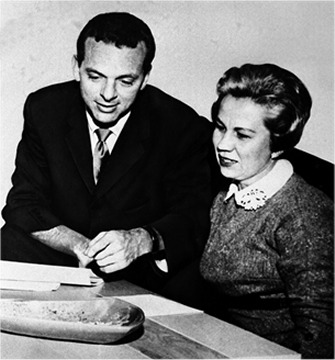
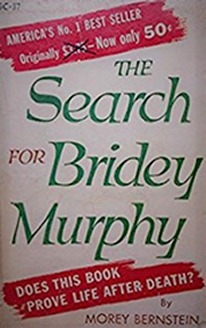
Memories of past lives is a common theme in reincarnation
fiction and there are several quasi-scientific papers written on the subject,
some serious and some fanciful. The most famous case of reincarnation memories
was Bridey Murphy. In 1952, Colorado businessman and amateur hypnotist
Morey Bernstein put housewife, Virginia Tighe, of Pueblo, Colorado, in
a trance that sparked off startling revelations about Tighe's alleged past
life as a 19th-century Irishwoman and her rebirth in the United States
59 years later. Bernstein used a technique called hypnotic regression,
during which the subject is gradually taken back to childhood. He then
attempted to take Virginia one step further, before birth, and was astonished
to find he was listening to Bridey Murphy.
Tighe's tale began in 1806, when Bridey was eight years
old and lived in a house in Cork. She was the daughter of Duncan Murphy,
a barrister, and his wife Kathleen. At the age of 17, she married barrister
Sean Brian McCarthy, who she claimed taught at Queen's University Belfast
After her death, she was reborn in America, although Tighe/Bridey wasn’t
how this event happened. Virginia Tighe herself was born in the Midwest
in 1923, had never been to Ireland, and did not speak with even the slightest
hint of an Irish accent.
The biographical details related by Bridey were not fully
checked before the publication of Bernstein's 1956 book The Search
for Bridey Murphy. However, once the book had become a bestseller,
almost every detail was thoroughly checked by reporters who were sent to
Ireland to track down the background of the elusive woman. It was then
that the first doubts about her "reincarnation" began to appear. Bridey
said she was born on December 20, 1798, in Cork and that she had died in
1864. There was no record of either event. She pronounced her husband's
name as "See-an," but Sean is pronounced "Shawn" in Ireland. Moreover Queen's
University Belfast did not exist at the time Tighe/Bridey said her husband
worked there.
Brian, which is what Bridey preferred to call her husband,
was also the middle name of the man to whom Virginia Tighe was married.
Some of the details did tally. For instance, her descriptions of the Antrim
coastline were very accurate. So, too, was her account of a journey from
Belfast to Cork. She claimed she went to a St. Theresa's Church. There
was indeed one where she said there was, but it was not built until 1911
– long after Bridey’s death. The young Bridey shopped for provisions with
a grocer named Farr. It was discovered that such a grocer had existed.
The experts who examined the case of Virginia Tighe came
to the conclusion that the best way to arrive at the truth was not check
in Ireland, but investigate Tighe's childhood relationship with her parents.
Morey Bernstein stated that Virginia Tighe (whom he called Ruth Simmons
in the book) was brought up by a Norwegian uncle and his German-Scottish-Irish
wife. However, it did not reveal that her actual parents were part Irish
and that she had lived with them until the age of three. It also did not
mention that an Irish immigrant named Bridie Murphy Corkell (1892–1957)
lived across the street from Tighe's childhood home in Chicago, Illinois.
Investigators (unnamed or long-forgotten) were satisfied that everything
Virginia Tighe said can be explained as repressed memories of her early
childhood and any paranormal interpretation of the case was "thoroughly
disproven."
I didn’t find any references to memories of future lives
other than a few novels of questionable quality. Evidently, Burroughs created
the “Universal Memory” theory. I considered Dickens’ The Ghost of Christmas
Future briefly, but decided that this fictional supernatural encounter
didn’t quality. A ghost is not a memory of a future life. It’s probably
nothing more than a bit of undigested roast beef.
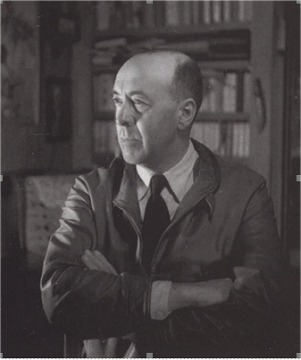
Burroughs was fascinated with the extension of life, at least
in his writings. He wrote about achieving longevity by special abilities
granted at birth (John Carter), resurrection through astral projection
(John Carter), a planet of Methuselahs (Barsoom), eternal youth through
the surgical insertion of the brain into of new bodies (The Mastermind
of Mars), witchcraft (Tarzan’s Quest), the illusion
of time (Pellucidar and The Moon Maid), reincarnation
(The Eternal Savage and The Moon Maid), suspended
animation (“The Reincarnation of Jimber-Jaw” and “The
Eternal Savage”), and Universal Memory (The Moon Maid).
Did this fascination carry over into real life? The following
notation is from the Edgar Rice Burroughs Timeline as compiled by Bill
Hillman and available at
http://www.erbzine.com/bio/years20.html
It is based on information from the Burroughs Family
Archives furnished by Danton Burroughs and suggests that Burroughs did
indeed experiment with the extension of life.
Ed orders numerous bottles of Prim from a
St. Louis lab (Prim Oil: herbal bee pollen mixture appears to have many
qualities: deodorant, vitamins, aids for hardening of arteries, heart,
PMS, MS, inflammation, release of sex hormones, lowering cholesterol, etc.)
(In his quest for health, fitness and longevity Ed was very aware of health
and fitness aids and is even rumored to have tried injections of monkey
glands at one time.)
Would that it had worked and would that Burroughs shared
it with us. Maybe he did and we haven’t figured it out. No doubt the current
incarnation of the Julian line knows the secret.
With a little luck, we can find him and ask.
To quote another fictional character,
“Live long and prosper.”

Addendum One
Edgar Rice Burroughs and the Quest for Immortality
By Robert Allen Lupton
Since I wrote Edgar Rice Burroughs and the Quest
for Immortality a few months ago, two fellow Burroughs aficionados and
ERBAPA contributors provided me with additional information that I didn’t
include in the original article.
J. G. Huckenpohler, Ph. D. pointed out the longevity
injections in the Venus series and the witch doctor’s potion mentioned
in Tarzan and the Foreign
Legion.
Alan Hanson also mentioned the Vepajans blood-based
longevity serum from Pirates
of Venus. “The serum is injected every two years and not only
provides complete immunity from all diseases, but insures (sic) the complete
restoration of all wasted tissues.”
In Chapter Twenty-five of “Foreign Legion,” Tarzan
relates a story about how he saved a young appearing man’s life. The man
was a witch doctor and offered to confer long life on Tarzan as a reward.
The process was lengthy. “It required a full month of concocting vile
brews, observing solemn rituals, and the transfusion of a couple of quarts
of the witch doctor’s blood into my veins.”
Tarzan goes on to explain his second encounter with the
pursuit of longevity, the process detailed in Tarzan’s
Quest. He concludes by stating that everyone who received the compound,
including his monkey, show no signs of aging.
So Tarzan received two immortality treatments in the wilds
of Africa. In my original article, I listed the compound created in Tarzan’s
Quest under witchcraft and magic, but perhaps I was hasty.
Arcane rituals aside, perhaps, the method is “medicine,”
not magic. Both witch doctors used a specific and long-tested formulae
for their treatments, one to make a compound and one to make vile brews.
This is reinforced when compared to the Vepajan blood
based longevity serum mentioned in Pirates of Venus. Is it witchcraft,
magic, or science?
I’m reminded of one of Arthur C. Clarke’s laws,
“Any sufficiently advanced technology is indistinguishable from magic.”
Clearly, the serum presented in the Venus books is science-based,
and not magical in nature. If we ignore the African mumbo jumbo, Tarzan’s
two treatments aren’t that far removed from the treatment developed on
Amtor.
Burroughs presented this both ways, science and magic.
As Aldous Huxley said, “You pays your money and you takes your choice.”

ERBzine References: Book Info and Text
A
Princess of Mars
The
Mastermind of Mars
Tarzan’s
Quest
At
The Earth’s Core
Pellucidar
The
Eternal Lover
The
Resurrection of Jimber-Jaw
Elmer
The
Moon Maid
Tarzan
and the Foreign Legion
Pirates
of Venus
Tarzan’s
Quest












